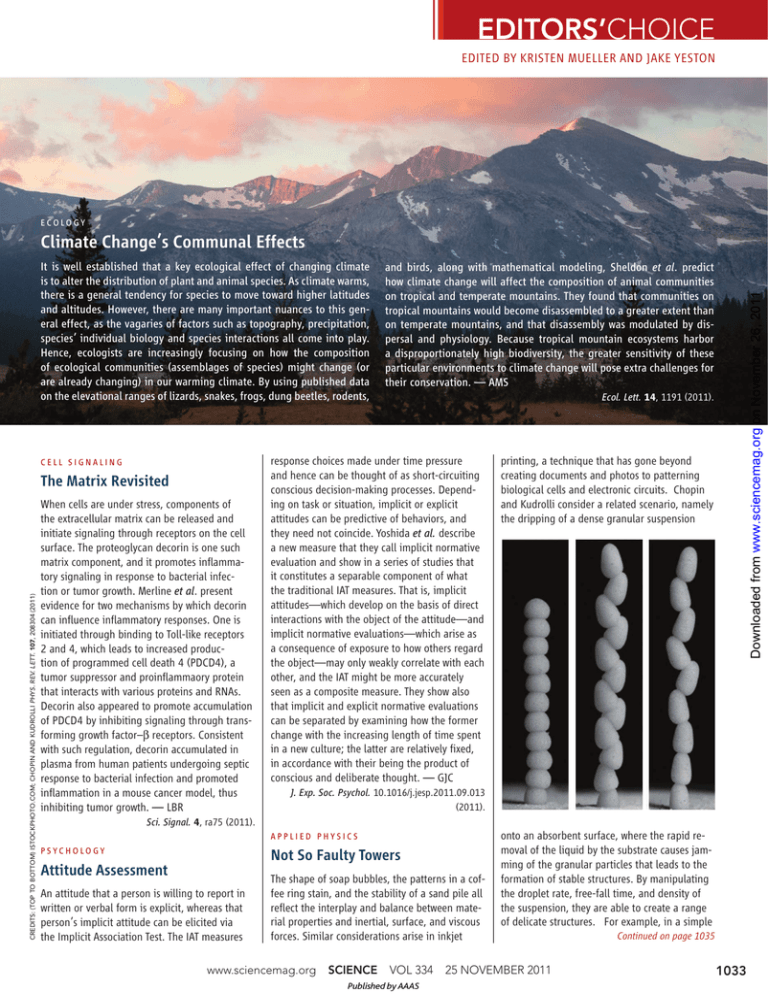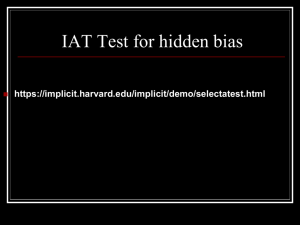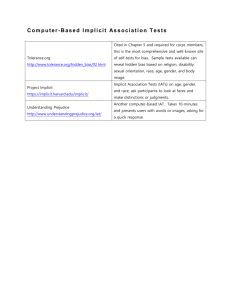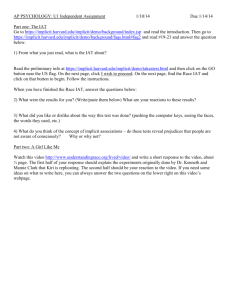EDITORS’CHOICE EDITED BY KRISTEN MUELLER AND JAKE YESTON
advertisement

EDITORS’CHOICE EDITED BY KRISTEN MUELLER AND JAKE YESTON ECOLOGY Climate Change’s Communal Effects CELL SIGNALING CREDITS: (TOP TO BOTTOM) ISTOCKPHOTO.COM; CHOPIN AND KUDROLLI PHYS. REV. LETT. 107, 208304 (2011) The Matrix Revisited When cells are under stress, components of the extracellular matrix can be released and initiate signaling through receptors on the cell surface. The proteoglycan decorin is one such matrix component, and it promotes inflammatory signaling in response to bacterial infection or tumor growth. Merline et al. present evidence for two mechanisms by which decorin can influence inflammatory responses. One is initiated through binding to Toll-like receptors 2 and 4, which leads to increased production of programmed cell death 4 (PDCD4), a tumor suppressor and proinflammaory protein that interacts with various proteins and RNAs. Decorin also appeared to promote accumulation of PDCD4 by inhibiting signaling through transforming growth factor–β receptors. Consistent with such regulation, decorin accumulated in plasma from human patients undergoing septic response to bacterial infection and promoted inflammation in a mouse cancer model, thus inhibiting tumor growth. — LBR and birds, along with mathematical modeling, Sheldon et al. predict how climate change will affect the composition of animal communities on tropical and temperate mountains. They found that communities on tropical mountains would become disassembled to a greater extent than on temperate mountains, and that disassembly was modulated by dispersal and physiology. Because tropical mountain ecosystems harbor a disproportionately high biodiversity, the greater sensitivity of these particular environments to climate change will pose extra challenges for their conservation. — AMS Ecol. Lett. 14, 1191 (2011). response choices made under time pressure and hence can be thought of as short-circuiting conscious decision-making processes. Depending on task or situation, implicit or explicit attitudes can be predictive of behaviors, and they need not coincide. Yoshida et al. describe a new measure that they call implicit normative evaluation and show in a series of studies that it constitutes a separable component of what the traditional IAT measures. That is, implicit attitudes—which develop on the basis of direct interactions with the object of the attitude—and implicit normative evaluations—which arise as a consequence of exposure to how others regard the object—may only weakly correlate with each other, and the IAT might be more accurately seen as a composite measure. They show also that implicit and explicit normative evaluations can be separated by examining how the former change with the increasing length of time spent in a new culture; the latter are relatively fixed, in accordance with their being the product of conscious and deliberate thought. — GJC APPLIED PHYSICS Not So Faulty Towers Attitude Assessment An attitude that a person is willing to report in written or verbal form is explicit, whereas that person’s implicit attitude can be elicited via the Implicit Association Test. The IAT measures printing, a technique that has gone beyond creating documents and photos to patterning biological cells and electronic circuits. Chopin and Kudrolli consider a related scenario, namely the dripping of a dense granular suspension J. Exp. Soc. Psychol. 10.1016/j.jesp.2011.09.013 (2011). Sci. Signal. 4, ra75 (2011). PSYCHOLOGY Downloaded from www.sciencemag.org on November 26, 2011 It is well established that a key ecological effect of changing climate is to alter the distribution of plant and animal species. As climate warms, there is a general tendency for species to move toward higher latitudes and altitudes. However, there are many important nuances to this general effect, as the vagaries of factors such as topography, precipitation, species’ individual biology and species interactions all come into play. Hence, ecologists are increasingly focusing on how the composition of ecological communities (assemblages of species) might change (or are already changing) in our warming climate. By using published data on the elevational ranges of lizards, snakes, frogs, dung beetles, rodents, The shape of soap bubbles, the patterns in a coffee ring stain, and the stability of a sand pile all reflect the interplay and balance between material properties and inertial, surface, and viscous forces. Similar considerations arise in inkjet www.sciencemag.org SCIENCE VOL 334 Published by AAAS onto an absorbent surface, where the rapid removal of the liquid by the substrate causes jamming of the granular particles that leads to the formation of stable structures. By manipulating the droplet rate, free-fall time, and density of the suspension, they are able to create a range of delicate structures. For example, in a simple 25 NOVEMBER 2011 Continued on page 1035 1033 EDITORS’CHOICE Continued from page 1033 tower built from linearly stacked droplets, the final shape of each segment depends on how the substrate (filter paper or a porous bed of glass beads) varies the drainage rate of the fluid. As the flux rate increases, towers become wider and smoother; individual segments lose their corrugated nature and begin to fuse into each other as neighboring droplets can interact before jamming occurs. Perhaps most unusual are the towers formed from low-impact droplets at high packing fraction, which can be stacked in a zig-zag fashion. — MSL pathology in humans. Despite early damage to lungs after infection, they had essentially returned to normal 3 months later. Repair was initiated by stem cells that proliferated in the bronchiolar epithelium and migrated to sites of damage, where they formed clusters around bronchioles and differentiated into alveolar structures destroyed by the infection. Taking a different approach, Ding et al. surgically removed the left lung of mice, which is known to drive the formation of more alveoli in the CHEMISTRY A Probe of Homogeneity One of the commonly touted advantages of homogeneous catalysis is that the catalyst structure is well defined. Dissolved molecules— as distinct from extended crystalline (or in some cases noncrystalline) surfaces—can be characterized and modified with high precision, and their interactions with substrates can be modeled in sharp detail, all in the service of optimizing their performance. Of course, such a path toward optimization relies critically on the knowledge that the active catalyst is in fact dissolved. If aggregated particles prove responsible for some or all of the catalytic activity, the implications of modifying the catalyst structure become far less clear. Esfandiari and Blum explore this question in the context of an olefin metathesis catalyst widely used for polymerization. Because the catalyst is only partially soluble in the medium, the appearance of the reaction mixture raises the possibility of activity at the solid-liquid interfaces. However, by carefully applying fluorescence microscopy with (submicrometer) single-particle resolution, the authors determine that nascent polymer does not accumulate at the sites of undissolved catalyst particles; rather, the data are consistent with fully homogeneous catalysis in the surrounding solution. — JSY J. Am. Chem. Soc. 133, 18145 (2011). CREDIT: KUMAR ET AL., CELL 147, 525 (2011) BIOMEDICNE How to Breathe Easier Although few organisms are able to fully regenerate new tissue after injury, tissue can often be repaired. The specific mechanisms that drive such repair, however, are not fully elucidated. Two studies use different models of lung injury in mice to uncover mechanisms that drive lung repair and regeneration. Kumar et al. infected mice with influenza A virus, severe cases of which can cause extensive, life-threatening lung www.sciencemag.org SCIENCE remaining lung. Pulmonary capillary endothelial cells initiated this regeneration by producing angiocrine factors, which promoted the proliferation of epithelial progenitor cells. Studies such as these may aid in the development of therapies to treat lung pathologies. — BJ Cell 147, 525; 539 (2011). OCEAN SCIENCE The Flow from Fukushima As engineers continue their efforts to stabilize the Fukushima Daiichi nuclear power plant, marine scientists are studying the amount and distribution of radioactive material released into the ocean. Sources include atmospheric fallout, release of contaminated freshwater and seawater used to cool the reactors, and contaminated groundwater discharges, but the overall magnitude of the contamination is not well documented. Buesseler et al. have analyzed ocean data from TEPCO (Tokyo Electric Power Company) and the Japanese Ministry of Education, Culture, Sports, Science and Technology (MEXT) in comparison to data acquired before the accident. Ocean discharges peaked in early April, 1 month after the accident, but levels of cesium-137 remained more than 10,000 times higher than normal through the end of July, indicating continued release from the reactors or other sources. The impact on marine biota and humans through direct exposure is likely to be minimal, but further study is required to understand the full effects of bioaccumulation and associated implications for seafood and seaweed consumption by humans. — JFU Environ. Sci. Technol. 45, 10.1021/es202816c (2011). VOL 334 25 NOVEMBER 2011 Published by AAAS Downloaded from www.sciencemag.org on November 26, 2011 Phys. Rev. Lett. 107, 208304 (2011).






